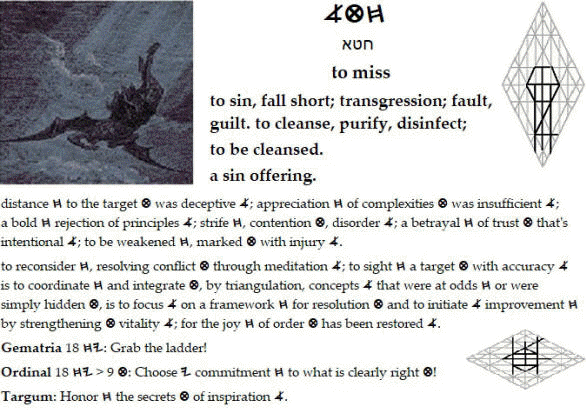Valley of the Shadow
Is Iniquity Sin?

![]()
As a generalization, the connotations of sin cover a broad range of errors, from simple mistakes to instances of gross malfeasance. When rendered into English, afj, the Hebrew word for sin, has greater clarity in common usage than does the Hebrew word for iniquity nwo. My explanation for reluctance to define iniquity is that the word is fundamentally visceral: the concept of iniquity touches upon and cannot long avoid the mystery of Lucifer, the fallen angel. We'd rather leave those questions alone.
Most will admit to a negative reaction to “iniquity,” but their understandings of the word’s actual meanings remain unclear. Even though mention of iniquity might send chills along the spine when it’s raised in conversation, not many are troubled enough by their reactions to dig into meanings and settle their concerns about the word's implications for the way they conduct their daily lives.
The opening illustration presents definitions for “sin,” as written in Torah’s original language. The meanings derived from the oracular emblems don’t refute standard etymological definitions. To the contrary, they affirm and expand them, opening the seals of scripture's rich subtexts to inquisitive minds.
The Moses Script is also known as Sinaitic Hebrew. The bones of all Western alphabets are at play in the vernacular language of Egypt at the Exodus. The alefbet served as the written language of Y'SharAL beyond the reign of King David, unto the rise of the Ezra script. Never wholly forgotten, it is still in use today in isolated villages of rural Yemen.
At his death, David was gathered to his Fathers, among whom he remains; and the spiritual kingdom he once led awaits restoration. His kingdom, the Kingdom of Heaven—of Names—is the state of being in which blameless intention blossoms. God’s Kingdom is the reality behind mythical Camelot; and the Father is calling upon a new generation to rebuild David’s Tabernacle: not his buildings, but the ambiance of his world view. Whether or not we are privileged to share in that restoration, we ought to have interest in how David saw his world and, also, in how he approached the scriptures upon which his world was founded.
The shepherd king of Yerushaliem read the Lively Oracles written in an alefbet whose twenty-two letters are ciphers derived from the grid of the pattern mandated on Sinai. That pattern, from which Moses was not permitted to deviate, is the sigil of the Logos of which John the Baptist testified.
The root of all language and mathematics, the divine pattern that became known as “the Word” springs from the purity of the Father’s heart. Projected by the eternal Father, that purity has been shed abroad upon the children of men.
| The Heap | ||
|
site |
Mystery Menu |
book |